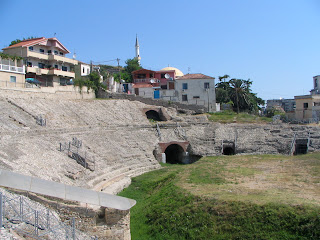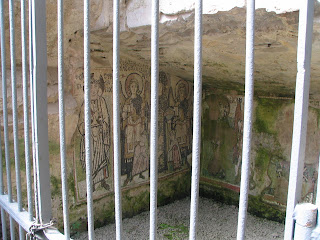



 I'm getting back to my Durrës entries. These are of Roman-era Durrës, known then as Dyrrachium. In grand functionality of design, there is not a lot of difference between a Roman amphitheater and a modern football stadium. The top photo is of the walkway inside the main level where attendees walked around to their seats. The alternating brick and stone layers in the wall was the Roman engineers' way of protecting against earthquakes.
I'm getting back to my Durrës entries. These are of Roman-era Durrës, known then as Dyrrachium. In grand functionality of design, there is not a lot of difference between a Roman amphitheater and a modern football stadium. The top photo is of the walkway inside the main level where attendees walked around to their seats. The alternating brick and stone layers in the wall was the Roman engineers' way of protecting against earthquakes.The next picture is of the inside of the amphitheatre. This one would seat around 15,000, which is about a third of the Coliseum in Rome. Note the mosque in the background.
During excavations about 40 skeletons with broken necks were found -- unsuccessful gladiators, I assume. After gladiating (is that a word?) was banned the theater was abandoned, and the Byzantine church took it over for a church and cemetery in about the 6th Century. The mosaics behind the bars are of that era. There is a small stone baptismal font outside the entry to this chapel.
Unlike in Rome, this theater has been built right up to and in -- note the house in the next picture. Excavations are going on right around this house. Getting the house emptied will no doubt be a problem -- I don't know that eminent domain works well here. It would displace several families (judging by the number of satellite dishes and antennae on the roof) who have no doubt lived here for years.
The bottom picture is in a different area of town, about 1000 yards as the crow flies from the amphitheater. These Corinthian columns are what remains of the Byzantine-era forum.
No comments:
Post a Comment